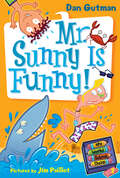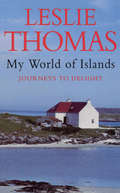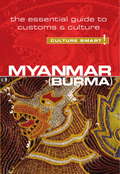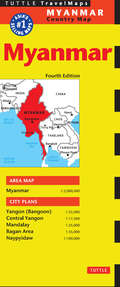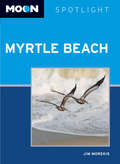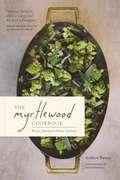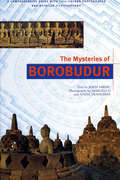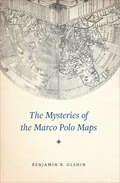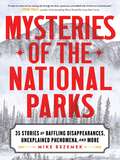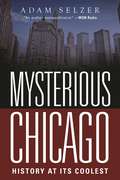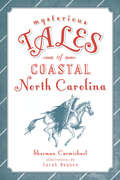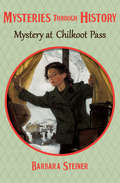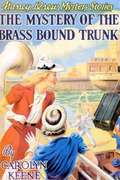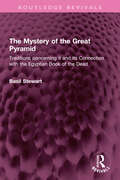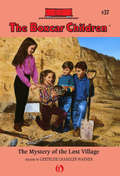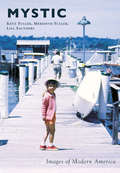- Table View
- List View
My Vermont Table (Six) Seasons: Recipes For All (six) Seasons
by Gesine Bullock-PradoVermont—arguably the OG farm-to-table state—is celebrated through 100+ recipes and stories from celebrated pastry chef Gesine Bullock-Prado. When Gesine Bullock-Prado left her Hollywood life in 2004 and moved to Vermont, she fell in love with the Green Mountain State’s flavors and six unique seasons. Spring, summer, fall, and winter all claim their place at this table, but a true Vermonter holds extra space for maple-forward mud season—that time of year before spring when thawing ice makes way for mucky roads—and stick season, a notable period of bare trees and gourds galore prior to winter. In My Vermont Table, Bullock-Prado takes readers on a sweet and savory journey through each of these special seasons. Recipes like Blackberry Cornmeal Cake, Vermont Cheddar Soup, Shaved Asparagus Toasts, and Maple Pulled Pork Sliders utilize local produce, dairy, wine, and flour. And quintessential Vermont flavors are updated with ingredients and spices from Bullock-Prado’s own backyard. With stunning photography, Vermonters and visitors alike will revel in a seat at this table.
My Weird School Daze #2: Mr. Sunny Is Funny! (My Weird School Daze #2)
by Dan GutmanWith more than 30 million books sold, the My Weird School series really gets kids reading!In the second book in My Weird School Daze—the hilarious second arc of the My Weird School series—A.J. is taking a much-needed summer vacation with his family. But all bets are off when Andrea and her family rent the beach house next door. Not even the funny beach lifeguard Mr. Sunny can save them from this weird summer!Perfect for reluctant readers and word lovers alike, Dan Gutman's insanely popular My Weird School series has something for everyone. Don't miss the hilarious adventures of A.J. and the gang.
My Whale of a Tale
by David Martinez Molly SmithDavid's class is going on a seafaring field trip along the rocky coast of Maine. What marine life will they see? Read David's account of the trip to find out.
My Wild Garden: Notes from a Writer's Eden
by Meir ShalevA colorfully illustrated round of the season in the garden of the best-selling novelist, memoirist, and champion putterer with a wheelbarrow On the perimeter of Israel&’s Jezreel Valley, with the Carmel mountains rising up in the west, Meir Shalev has a beloved garden, &“neither neatly organized nor well kept,&” as he cheerfully explains. Often covered in mud and scrapes, Shalev cultivates both nomadic plants and &“house dwellers,&” using his own quirky techniques. He extolls the virtues of the lemon tree, rescues a precious variety of purple snapdragon from the Jerusalem–Tel Aviv highway, and does battle with a saboteur mole rat. He even gives us his superior private recipe for curing olives. Informed by Shalev&’s literary sensibility, his sometime riotous humor, and his deep curiosity about the land, My Wild Garden abounds with appreciation for the joy of living, quite literally, on Earth. Our borrowed time on any particular patch of it is enhanced, the author reminds us, by our honest, respectful dealings with all manner of beings who inhabit it with us.
My World Of Islands
by Leslie ThomasLeslie Thomas's odyssey is a vivid, personal account of the most fascinating islands at the furthest reaches of the globe: to islands as distant and diverse as Saint-Pierre et Miquelon off Newfoundland and Great Barrier Island off New Zealand, and to places more familiar by name, including Nantucket, Fair Isle, Tahiti, and Capri, this journey voyages to the world's smaller places.Descriptive, evocative and liberally sprinkled with anecdotes, the book weaves together a tapestry of impressions. Beachcombing for local legends, geography, colonial history and maritime lore, Thomas's search for the mystique of these islands gives the reader a unique insight into an extraordinary and beautiful world of islands.'My World of Islands reads as a paean to a past age... a reminder that the entire world has not yet been reduced to Frejus or Marbella' Times Literary Supplement
Myanmar - Culture Smart!
by Nicholas Nugent Kyi Kyi MayMyanmar, as Burma is now known, is strategically situated between the world's two most populous nations--China and India--and its distinctive ancient culture shares some traditions with both countries. Hidden away from the eyes of the world for half a century by its military rulers' policy of self-isolation, "the Burmese Way to Socialism," with a new democratic parliament and civilian government Myanmar is undergoing important changes as it approaches its next elections in 2015. Its most famous political detainee, Aung San Suu Kyi, the Nobel peace laureate, has been released after nearly twenty years of house arrest. The present administration faces teething problems in politics, governance, education, its dealings with over a hundred ethnic groups, and its society. At the same time, progress has been made with the emergence of a free press, the release of political prisoners, and the reemergence of the long-lost voice of the man and woman on the street. The country is opening up to tourism and business. The Burmese people are by nature friendly and polite, and are traditionally easy-going and peaceable. Most are devout Buddhists, and there are pagodas and meditation centers all over the country. They are also great lovers of fun, entertainments, and festivals--in fact, there is a festival for each Myanmar calendar month Culture Smart! Myanmar provides much needed information about a country taking its first steps to becoming an important player on the world stage. It offers invaluable insights into the inner life of the Burmese, their history, traditions, attitudes, and work ethic, and gives practical advice on what to expect and how to behave in different circumstances. While their hosts may be naturally polite and accommodating, foreign visitors will have to go through a steep learning curve to understand the dos and don'ts of Burmese social customs. This book serves as an essential guide for Western tourists and entrepreneurs who are interested in visiting or doing business in this beautiful, enigmatic, and resource-rich country.
Myanmar Travel Map
by Periplus EditionsThe third edition of this specialist regional map, covering Shanghai Area at a scale of 1:2,000,000 and Pudong at a scale of 1:85,000. It also features detailed city plans of Shanghai at 1:15,000, Suzhou at 1:22,000 and Hangzhou at 1:28,500. There are also useful travel tips on getting around, accommodation and dining, shopping and nightlife and services.
Myanmar Travel Map Fourth Edition (Periplus Travel Maps)
by Periplus EditorsThe Myanmar Travel Map from Periplus is designed as a convenient, easy-to-use tool for travelers. <P><P>Created using durable coated paper, this map is made to open and fold multiple times, whether it's the entire map that you want to view or one panel at a time.Following highways and byways, this map will show you how to maneuver your way to banks, gardens, hotels, golf courses, museums, monuments, restaurants, churches and temples, movie theaters, shopping centers and more!This 4th edition includes maps and plans that are scaled to: Area Map: Myanmar 1:2,000,000City Plans: Yangon (Rangoon) 1:35,000 Central Yangon 1:17,500 Mandalay 1:25,000Bagan Area 1:35,000Naypyldaw 1:100,000Periplus Travel Maps cover most of the major cities and travel destinations in the Asia-Pacific region. The series includes an amazing variety of fascinating destinations, from the multifaceted subcontinent of India to the bustling city-state of Singapore and the 'western style' metropolis of Sydney to the Asian charms of Bali. All titles are continuously updated, ensuring they keep up with the considerable changes in this fast-developing part of the world. This extensive geographical reach and attention to detail mean that Periplus Travel Maps are the natural first choice for anyone traveling in the region.
Myrtle Beach
by Jim MorekisMoon Spotlight Myrtle Beachis a 60-page compact guide covering the best of one of South Carolina's most popular tourist destinations. Travel writer Jim Morekis offers his firsthand advice on must-see attractions, as well as maps with sightseeing highlights, so you can make the most of your time. This lightweight guide is packed with recommendations on entertainment, shopping, recreations, accommodations, food, and transportation, making navigating this recreation-filled beach resort town uncomplicated and enjoyable. This Spotlight guidebook is excerpted fromMoon South Carolina.
The Myrtlewood Cookbook: Pacific Northwest Home Cooking
by Andrew Barton Peter SchweitzerExperience beautiful home cooking that takes its cues from the kitchen gardens and forest harvests of the Pacific Northwest. Andrew Barton and his friends run Secret Restaurant Portland, a monthly supper club. After hosting dinners for five years, a culinary style emerged that reflected his practical approach to cooking: accessible recipes alive with flavor, lovely on the plate and the palate. The Myrtlewood Cookbook brings forth 100 recipes that amplify the tastes, colors, and textures of summer tomatoes, fall mushrooms, winter roots, and spring greens. You will gain nearly as much from reading these recipes as from cooking them. Whether you are inspired to make Nettle Dumplings in Sorrel Broth, Candied Tomato Puttanesca, or Russet/Rye Apple Pie, be prepared to swoon under the spell of Myrtlewood.* *The Myrtlewood tree is found on the same ground as fiddlehead ferns, nettles, and other wild foods characteristic of the Pacific Northwest. The plates, bowls and cutting boards carved from Myrtlewood shown in this book connect to the land where this cookbook was created.
The Mysteries of Borobudur
by Marcello Tranchini John MiksicThe Mysteries of Borobudur provides a comprehensive guide to the history and architecture of the monument in word and picture, with an informative text, complemented by colour photographs, maps, site plans and other visual materials
The Mysteries of Borobudur
by Marcello And Tranchini John MiksicThe Mysteries of Borobudur provides a comprehensive guide to the history and architecture of the monument in word and picture, with an informative text, complemented by colour photographs, maps, site plans and other visual materials
The Mysteries of the Marco Polo Maps
by Benjamin B. OlshinWhat&’s the truth behind the travels of Marco Polo? &“A fascinating tale about maps, history and exploration.&”—Times Literary Supplement (UK) In the thirteenth century, Italian merchant and explorer Marco Polo traveled from Venice to the far reaches of Asia, a journey he chronicled in a narrative titled Il Milione, later known as The Travels of Marco Polo. While Polo&’s writings would go on to inspire the likes of Christopher Columbus, scholars have long debated their veracity. Some have argued that Polo never even reached China—while others believe that he came as far as the Americas. Now, there&’s new evidence for this historical puzzle: a very curious collection of fourteen little-known maps and related documents said to have belonged to the family of Marco Polo himself. Here, historian of cartography Benjamin B. Olshin offers the first credible book-length analysis of these artifacts, charting their course from obscure origins in the private collection of Italian-American immigrant Marcian Rossi in the 1930s; to investigations of their authenticity by the Library of Congress, J. Edgar Hoover, and the FBI; to the work of the late cartographic scholar Leo Bagrow; to Olshin&’s own efforts to track down and study the Rossi maps, all but one of which are in the possession of Rossi&’s great-grandson. Are the maps forgeries, facsimiles, or modernized copies? Did Marco Polo&’s daughters—whose names appear on several of the artifacts—preserve in them geographic information about Asia first recorded by their father? Or did they inherit maps created by him? Did Marco Polo entrust the maps to an admiral with links to Rossi&’s family line? Or, if the maps have no connection to Marco Polo, who made them, when, and why? Regardless of the maps&’ provenance, this tale takes us on a fascinating journey, offering insights into Italian history, the age of exploration, and the wonders of cartography. &“Olshin&’s book tugs powerfully at the imagination of anybody interested in the Polo story, medieval history, old maps, geographical ideas, European voyages of discovery, and early Chinese legends.&”—The Wall Street Journal
Mysteries of the Mummy Kids (Journeys Series)
by Kelly Milner HallsThe mysteries of kid mummies cover North and South American, Egyptian, Asian, and European.
Mysteries of the National Parks: 35 Stories of Baffling Disappearances, Unexplained Phenomena, and More
by Mike BezemekDiscover the hidden mysteries of America's national parks!America's national parks are best known for stunning beauty and outstanding adventure—but these natural wonders also hold some of the world's greatest mysteries. Why did an ancestral civilization abandon their stone cities in the mountains of Colorado? Flying past Mt. Rainier, did a pilot really spot nine shiny objects that spawned the UFO craze? Was a contorted crater in Utah's dramatic Canyonlands created by a meteorite strike? Join outdoor expert and writer Mike Bezemek as he explores baffling disappearances, unexplained phenomena, and the secret history of our national parks.Featuring 35 puzzling stories, Mysteries of the National Parks takes readers to every corner of our diverse and beautiful country. You'll explore some of the most beloved national park units, including:Yellowstone National ParkGrand Canyon National ParkDinosaur National MonumentBlue Ridge ParkwayFord's Theatre National Historic SiteAnd many more!Mysteries of the National Parks is the first book to delve into the most enigmatic happenings across the National Park Service. Bezemek's vivid storytelling brings each mystery to life, immersing readers in the intriguing settings and legendary characters while revealing previously untold details. Meanwhile, readers will learn how to visit these mystifying sites. Whether you're an outdoor adventurer, national park enthusiast, or true crime fan, this riveting collection is a must-have addition to your library. Perfect as a gift or unique travel companion, Mysteries of the National Parks will leave you ready to set out on your own national park adventure.
Mysterious Chicago: History at Its Coolest
by Adam SelzerFrom Chicago historian Adam Selzer, expert on all of the Windy City's quirks and oddities, comes a compelling heavily researched anthology of the stories behind its most fascinating unsolved mysteries.To create this unique volume, Selzer has collected forty unsolved mysteries from the 1800s to modern day. He has poured through all newspaper, magazine, and book references to them, and consulted expert historians. Topics covered include who really started the great Chicago fire, who was the first "automobile murderer," and even if there was actually a vampire slaying at Rose Hill cemetery.The result is both a colorful read to get lost in, a window to a world of curiosity and wonder, as well as a volume that separates fact from fiction-true crime from urban legend.Complementing the gripping stories Selzer presents are original images of the crime and its suspects as developed by its original investigators. Readers will marvel at how each character and crime were presented, and happily journey with Selzer as he presents all facts and theories presented at the time of the "crime" and uses modern hindsight to assemble the pieces.
Mysterious Scotland: Enigmas, Secrets and Legends
by Michael BalfourMysterious Scotland presents an extraordinary array of the weird and wonderful heritage of the country. Michael Balfour examines strange stories from the moors, forests, rivers, holy wells and lochs, where - as well as the old legends and dark secrets which he prises out of palaces, castles and cathedrals - he finds monsters, ghoulies, unsolved murders and ancient cures.Investigating a land where the past is reflected in the present, the author has roamed all around Scotland, exploring standing stones, mermaid beaches and magic springs. He seeks out new theories about the prehistoric, Celtic and Pictish stones, carvings, tombs and brochs which are scattered across the country. Among his many wonderful discoveries, he unearths long-forgotten prophecies, puzzling tales from the bothies, consuming traditions and distillers' tricks, and finds evidence of the legendary Highland second sight. Not forgotten are the great historical figures who throng the pages, each making a unique contribution to Mysterious Scotland. This book is the perfect introduction to the amazing hidden history which permeates Scottish lives and landscape.
Mysterious Tales of Coastal North Carolina (Forgotten Tales)
by Sherman Carmichael Sarah HaynesMaster storyteller Sherman Carmichael ventures into the Tar Heel State to deliver strange and mysterious tales along the coast. Read about shipwrecks such as that of the SS Liberator, which still sits at the bottom of the ocean off the coast of Diamond Shoals, and legendary storms like the 1911 Water Spouts, which were described as tornadoes spinning wildly atop the ocean. Find out why the Cape Hatteras Lighthouse is said to be haunted by a large black cat. Learn about the origins of Boo Hag, a fiendish creature that sucks the life out of her victims as they sleep at night--a tale that originates from the rich Gullah culture of the Carolinas. Join Carmichael as he contemplates these stories and more from the mysterious side of North Carolina's beloved coastal counties.
Mystery at Chilkoot Pass (Mysteries through History #17)
by Barbara SteinerGold fever sweeps the country as a twelve-year-old aspiring writer travels to the Yukon with her family and best friend, fighting natural disasters and a clever thiefAfter traveling from San Francisco by steam ship, Hetty McKinley, her best friend, Alma, and their families prepare for the five-hundred-mile trek north to the gold fields of the Yukon. It&’s only September, but the Arctic Circle is already frigid. As the two families, along with hundreds of other prospectors, camp out for the night near the outpost of Dyea, Hetty catches a glimpse of the legendary Chilkoot Pass, the narrow gap through which they&’ll cross Alaska into Canada. But the next morning, Alma&’s mother discovers that all their money is gone! A few days later, Hetty&’s cherished locket, containing a photograph of her dead mother, disappears. More thefts soon follow, but these are the least of their problems. Soon, the group is battling typhoid, blizzards, and a terrifying avalanche. Will Hetty and her family and friends survive their journey to the top of the world? This ebook includes a historical afterword.
Mystery at Chilkoot Pass: An American Girl® Book (Mysteries through History #17)
by Barbara SteinerGold fever sweeps the country as a twelve-year-old aspiring writer travels to the Yukon with her family and best friend, fighting natural disasters and a clever thiefAfter traveling from San Francisco by steam ship, Hetty McKinley, her best friend, Alma, and their families prepare for the five-hundred-mile trek north to the gold fields of the Yukon. It&’s only September, but the Arctic Circle is already frigid. As the two families, along with hundreds of other prospectors, camp out for the night near the outpost of Dyea, Hetty catches a glimpse of the legendary Chilkoot Pass, the narrow gap through which they&’ll cross Alaska into Canada. But the next morning, Alma&’s mother discovers that all their money is gone! A few days later, Hetty&’s cherished locket, containing a photograph of her dead mother, disappears. More thefts soon follow, but these are the least of their problems. Soon, the group is battling typhoid, blizzards, and a terrifying avalanche. Will Hetty and her family and friends survive their journey to the top of the world? This ebook includes a historical afterword.
The Mystery Of The Brass Bound Trunk (Nancy Drew Mystery Stories #17)
by Carolyn Keene Russell H. TandyA trunk that Nancy receives from her father for a trip to Buenos Aires becomes the center of a mystery. Beginning in the late 1950s, the Nancy Drew books were revised and condensed. This is the version published in 1934, before the changes.
The Mystery of the Great Pyramid: Traditions concerning it and its Connection with the Egyptian Book of the Dead (Routledge Revivals)
by Basil StewartFirst published in 1929, The Mystery of the Great Pyramid attempts to unravel the secrets of the Great Pyramid by drawing parallels with the rituals in the Book of the Dead. The conception of the Pyramid and the origin of the cult of Osiris and of the Book of the Dead are to be found in a common source, which maybe expressed in the one word, Messianism. The author argues that this is why the literature of early Christian gnosticism abounds in mystical pyramid figures and associated astronomical conceptions and constellations. This book will be of interest to students of history, philosophy, and theology.
The Mystery of the Lost Village (Boxcar Children #37)
by Charles Tang Gertrude Chandler WarnerWhen the Aldens try to save a forest from developers in a Navaho Indian reservation by proving there is a lost village there, they're met with sabotage.
The Mystery of the Vasa (Fountas & Pinnell LLI Purple #Level S)
by Barbara FiermanFor hundreds of years the sinking of the Swedish warship Vasa was an unsolved mystery. But when a Swedish amateur archaeologist named Anders Franzen let his curiosity get the best of him, he was motivated to solve the mystery. This book describes the salvage and preservation of the Swedish warship Vasa that sank in Stockholm harbor on her maiden voyage in 1628.
Mystic (Images of Modern America)
by Meredith Fuller Kent Fuller Lisa SaundersSince Mystic, Connecticut, celebrated its 300th anniversary in 1954, it has evolved from a working-class village into a tourist-driven community while embracing its quaint New England charm and keeping its rich history alive. The shoreline village of two townships (Stonington to the east; Groton to the west) is divided by the Mystic River, which passes through the downtown center where the iconic bascule bridge unites the community. Many establishments occupy buildings preserved from Mystic's deeply anchored shipbuilding past. Towering wooden ships, beluga whales, creative arts, shops, restaurants, and events overflowing with Mystic's heart and soul attract hundreds of thousands of visitors each year.

